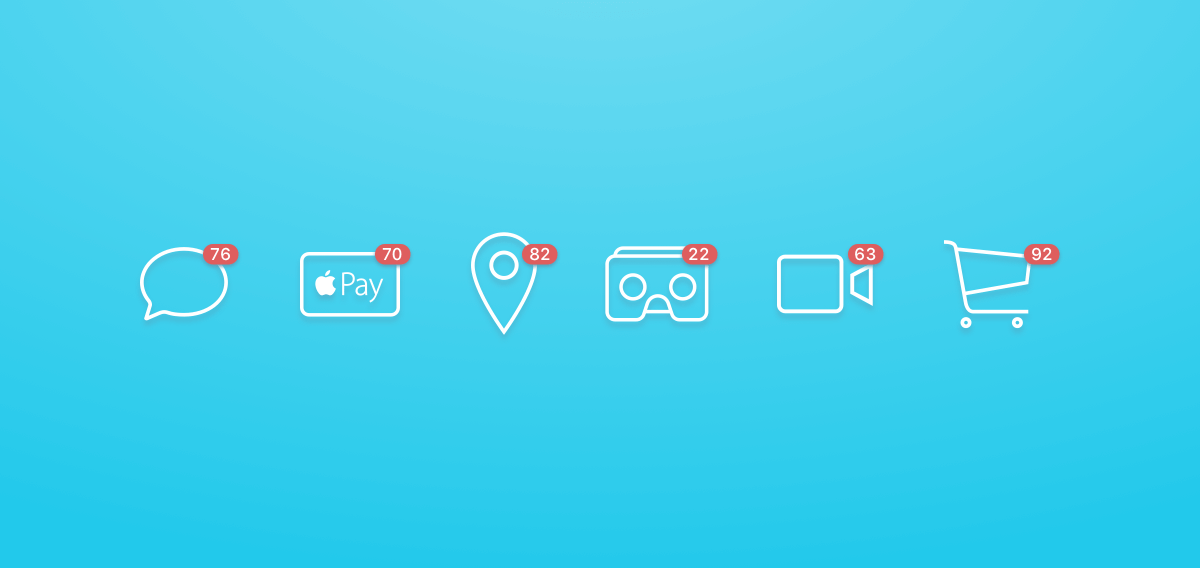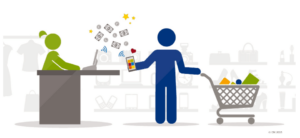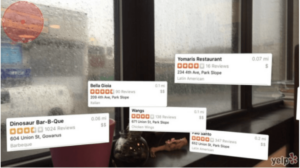Mobile usage is way up.
People love their smartphones.
77% of American adults now own a smartphone.
That’s up 35 percent from 2011.
There’s no denying that the power of mobile is changing the way people think.
Your mobile device can do more now than ever before. The top brands in the world are realizing this, and they’re acting on it. Apple’s already investing in an augmented reality platform because they know AR is a massive mobile trend that’s going to explode very soon. Just take a look at this picture from Facebook’s event where everyone tried on Oculus:
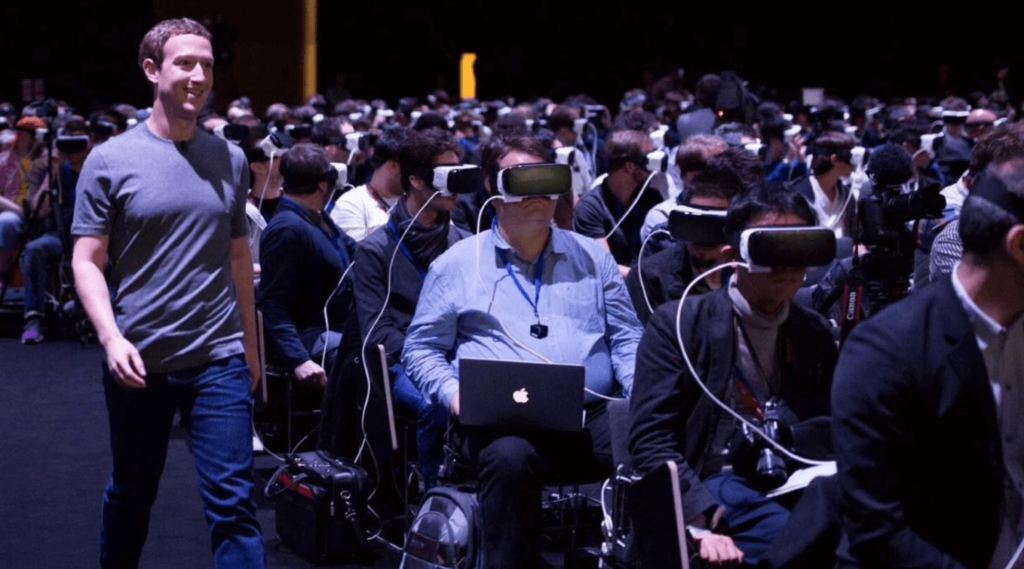
People love their phones, and if they can’t get to your business from their phones, you’re going to have a hard time reaching them.
Marketing executives can no longer be content to watch traffic flow in from the desktop. In fact, more people are now accessing the internet from their mobile phones than their desktops.
That’s a big deal!
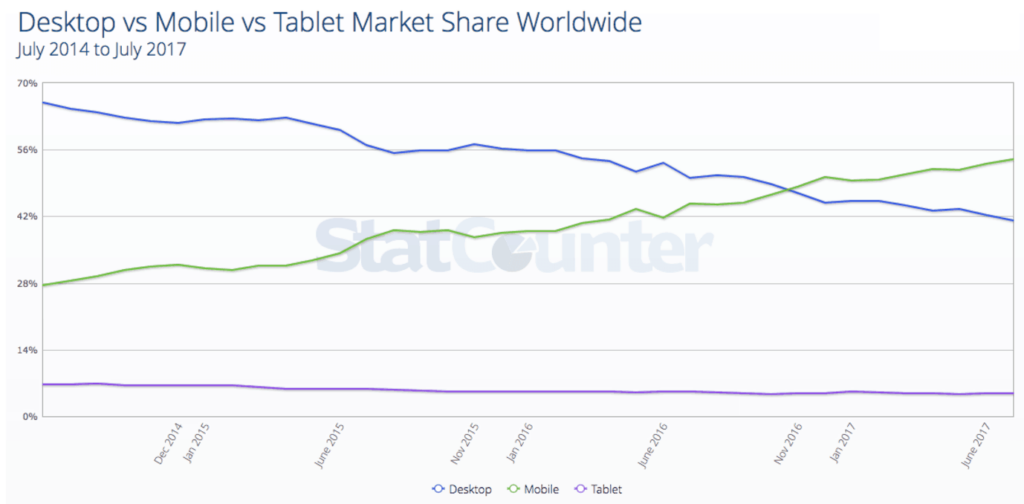
On top of that, mobile data usage is expected to skyrocket over the next few years. Business Insider Intelligence projects mobile data usage to increase 700 percent from 2016 to 2021. They’re also projecting that video content will take up around 80 percent of that data usage.
What it boils down to is this:
The best CMOs and the best brands are investing in mobile…
…because the future (and the present) is mobile.
Whether it’s developing a new iPhone app or investing in responsive design, the best CMOs are taking notice of mobile and investing in mobile-friendly experiences. Like every corner of the tech world, mobile is changing quickly—it seems like just yesterday people were using flip phones and sending SMS messages instead of Snaps. Not anymore…
So what does the future hold for mobile tech? Well, we’ve done some digging and put together a few mobile trends that the world’s best CMOs are keeping an eye on. Let’s take a look:
1. Video & Live Streaming
Video content is a mobile trend pretty much everyone is jumping on, and with good reason.
Adélie Studios found that businesses using video content grow company revenue 49 percent faster year-over-year than those who don’t. They also found that video posts on social media generate 1200 percent more shares than text and image posts combined.
The real trend here is the amount of video content being watched on mobile devices.
Over 50 percent of all YouTube content is viewed on mobile, and 90 percent of all Twitter video views happen on mobile. On top of that, the emergence of live video is creating a massive mobile trend. Until recently, you couldn’t even run a Facebook Live broadcast if you weren’t on mobile. Cisco projects live video on mobile to grow 39 times from 2016 to 2021, accounting for 5 percent of all mobile video traffic.
The biggest brands in the world are doubling down on video. You should do the same, and you should do it right. Quick pro tip: Don’t ignore vertical video. It’s heating up thanks to social media channels like Instagram and Snapchat making vertical video relevant.
2. Chatbot & Messaging Apps
Now more than ever, consumers are expecting businesses to be available 24/7.
According to the 2016 Mobile Messaging Report, 51 percent of people say they should be able to reach your business any time they need to—be it 11 at night or 4 in the morning. Even more significant, 64 percent expect your business to be available through messaging apps like Facebook Messenger and WhatsApp.
Time spent in mobile apps increased 69 percent in 2016, mainly thanks to a 394 percent increase year-over-year in time spent on messaging and social apps.
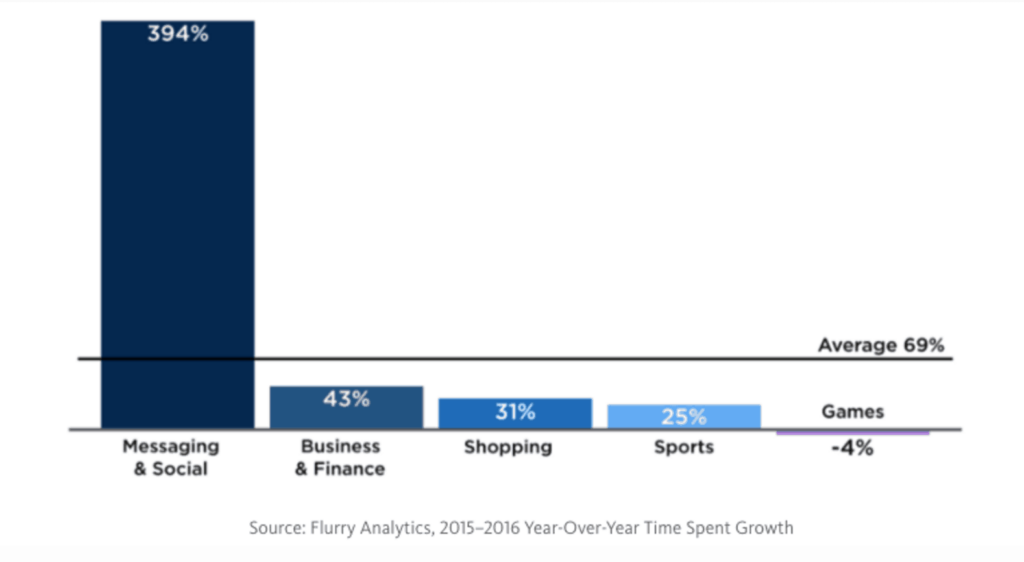
Of the 3.7 billion internet users worldwide, 2.1 billion are using messenger apps. That’s more than half the web-connected world—and nearly a third of the global population—using messenger apps.
On top of that, Business Insider Intelligence shows the top four messaging apps right now (Messenger, WhatsApp, WeChat and Viber) have more monthly active users than the top four social networking apps (Facebook, Instagram, Twitter and LinkedIn).
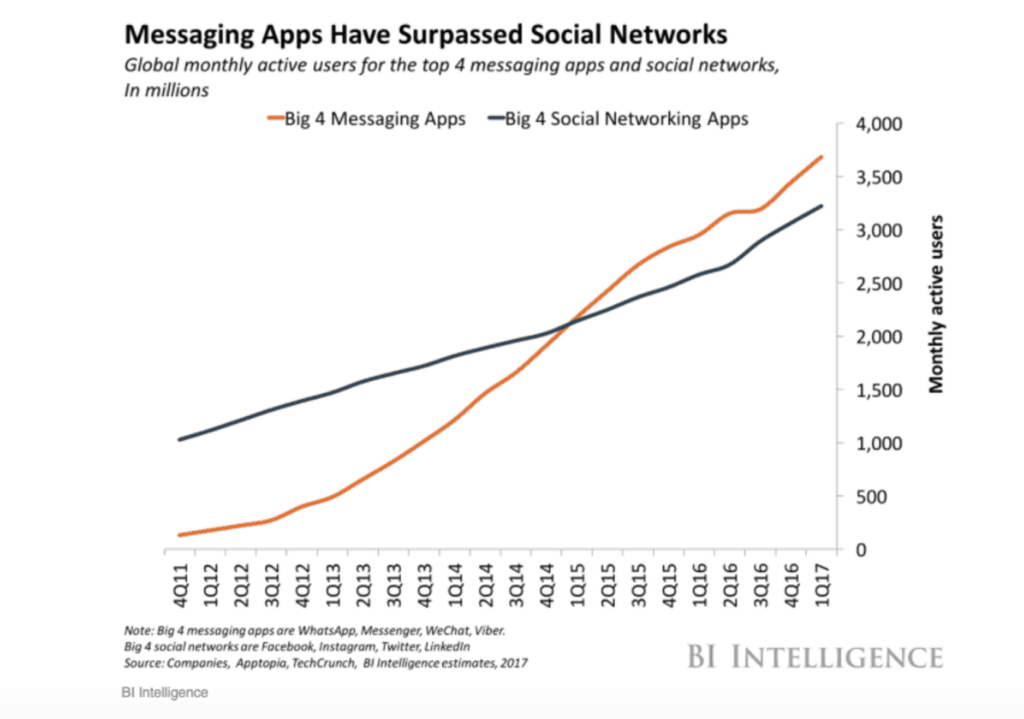
Social networking apps aren’t dying; messaging apps are just where it’s at right now.
So much so that they’re even on the verge of jumping ahead of email and phone calls as customers’ preferred method of communicating with a business. The 2016 Mobile Messaging Report found that 45.8 percent of people prefer to talk to a business through a messaging app vs. email, and 49.4 percent prefer messaging apps over phone calls.
Overall, messaging apps are already overtaking email for daily conversation—especially among the decision-makers of the future. Consumers under the age of 24 use email 3.5 times less than messaging apps, while 25- to 44-year-olds use email half as often as messaging apps.
Messaging apps are huge, and they’re where your brand needs to be right now.
3. Location-Based Marketing & Targeting
Imagine being able to send an ad to someone’s mobile device right as they’re about to walk past your business.
With everyone using their phones everywhere they go, the ability to target someone at the exact time they’re most likely to make a purchase is not only possible—it’s already happening.
Location-based marketing is a mobile trend that the brightest minds in the industry are pouncing on.
According to a survey of 500 marketing executives, 25 percent of marketing budgets are being spent on location-based marketing and over 50 percent of brands are using location data to target customers.
Using the GPS on your mobile device, businesses can target you with ads whenever you enter a certain location, called a geofence.
Geofencing is basically creating a virtual fence around an area. As soon as someone enters that area, they can access certain features or be targeted with ads, notifications, text messages, etc. Snapchat uses geofencing with their location-based filters that you can only access within designated areas, and Starbucks uses geofencing in tandem with their app to send you a push notification as soon as you’re within a certain distance of a Starbucks shop.
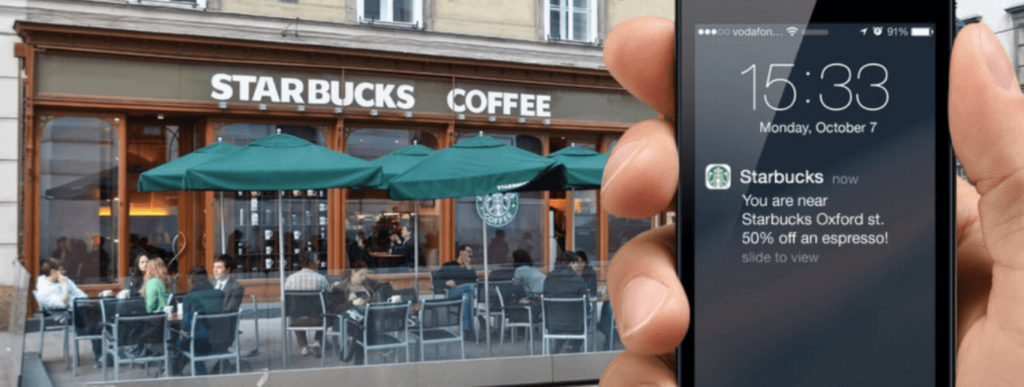
Digging even deeper: By analyzing a customer’s travel history over time, businesses can predict when they’ll be in certain places, then target them with offers accordingly. If someone goes to the library every Wednesday morning, and I own a coffee shop right up the road, I can use that location-based info to catch them on their Wednesday morning commute with an offer for a discounted americano to kick-start their day.
Mobile marketing meets espresso.
4. Mobile Wallets & Payment Systems
Next, imagine being able to target someone on their mobile device as they’re walking past your store with an ad or discount you know they’ll be interested in.
Smartphones are getting closer and closer to managing your entire day-to-day life and replacing some essentials, including your wallet.
Apple Pay, Google Wallet, even that Starbucks app are all taking the traditional transaction and moving it to your phone. In addition to the ease and simplicity, the marketing opportunities with mobile pay are endless. We talked about this briefly in one of our latest articles highlighting the clear ROI mobile offers when it comes to your top business goals.
Digital wallets = real-world money.
As customers make more and more purchases, you can analyze what they’re buying and send future offers their way that are more likely to pique their interest. Factor in the location-based piece, and brands can now hit customers with the perfect offer at the perfect time.
Think about it: A customer is browsing their favorite store when a notification pops up on their phone. It’s a one-time discount code for a product that your brand has been trying to push. Naturally, they pounce on it and buy.
The customer gets the product they want for a nice price. Your brand makes a sale. Everyone’s happy.
Over time, you will better understand what kind of products that particular customer likes, making your future offers that much more enticing.
5. Augmented Reality
One of the hottest mobile trends right now is augmented reality.
Using a smartphone’s camera, AR makes digital objects appear on the screen as if they’re in the real world. Think Pokemon Go and the infamous dancing hot dog on Snapchat.
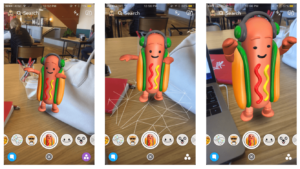
Obviously, the possibilities of augmented reality extend further than throwing virtual Pokeballs at Pidgeots in your front yard or watching a hot dog dance on your desk.
Imagine walking down the street and being able to pull out your phone, point it toward a restaurant, and see reviews from previous customers. Or imagine being able to take a look at what restaurants are around before you venture out into the rain using Augmented Reality.
Sort of like this:
That was a Yelp creation back in the early stages of AR in 2009, so just think about the possibilities today.
As mentioned, Apple is already working on ARKit, a platform that would allow iPhone app developers to include AR functionality in their mobile apps going forward. It’s only a matter of time before Android app development offers the same functionality.
IKEA has a 150-person team working on an app that would allow customers to virtually place furniture inside their homes using AR before actually making a purchase.
It’s not even too far-fetched to think about a future where your car’s front windshield features elements of augmented reality. For now though, we’ll keep the focus on mobile app development with AR functionality.
6. Mobile E-commerce
Mobile e-commerce (or m-commerce) is quickly becoming the new norm.
Business Insider Intelligence predicts that by 2020, m-commerce will make up 45 percent of the total e-commerce market in the United States. Considering the market is projected to exceed $600 billion, mobile e-commerce could be a $300 billion industry within the next three years.
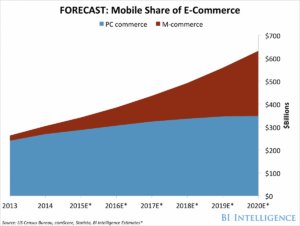
This means people are becoming more and more comfortable making purchases from their mobile devices, and the best marketers in the world are noticing.
Building off the location-based marketing and mobile wallet trends, the m-commerce explosion is cutting down more of the roadblocks that stand between a potential customer and a sale.
You no longer have to wait for someone to either commute to your location to buy in person, or bust open their laptop to buy online. Now, you can target them on their smartphone and prompt them to open up your mobile app and make a purchase—all without the hassle of entering info, thanks to new products like Apple Pay.
Mobile is making the pathway to a purchase so smooth it’s impossible for customers not to walk down it.
So What Next?
Mobile is booming.
Exciting times are ahead for the mobile world—and the chief marketing officers who take advantage of the opportunities in front of them.
The app stores are continuing to grow exponentially, with 2.2 million apps in the Apple App Store as of May 2017. A projection from early 2016 estimated that by 2020, there will be more than 5 million apps in the App Store.
That’s a thousand times more apps than there were in the Apple App Store’s early days in 2008.
Insane, right?
With so many apps on the market, the competition level is high. If your mobile app design is poor, your chances of taking off are much slimmer. In order to set yourself up for success, you need to make sure you understand the app design and creation process.
To lend a hand, we put together The Definitive Guide To Launching An App & Generating Traction, which you can download today for free. It’s a great resource that delves deep into the specific strategies and characteristics that differentiate the best apps from the rest.
If you’re interested in learning more about how we work with CMOs to develop mobile app strategies, schedule some time with us or take the time to learn a bit more about our Blueprint Process. We’d love to chat and are always excited to discuss mobile trends with organizations trying to reach ambitious goals.
